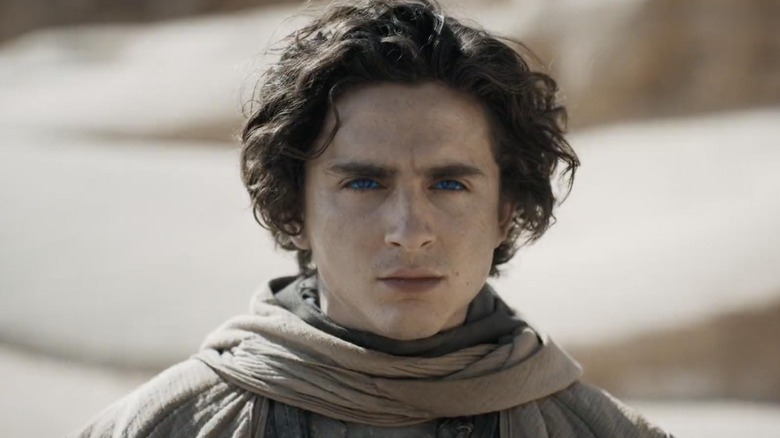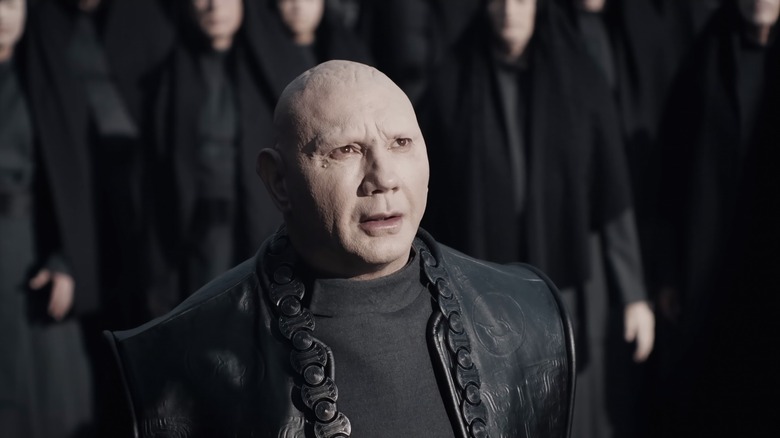A Comic That 'Haunted' Denis Villeneuve For Decades Inspired A Piece Of Dune 2 Tech
We may receive a commission on purchases made from links.
Few artists have etched imaginatively vivid, intricate Lovecraftian worlds like French comic artist Philippe Druillet, whose "The 6 Voyages of Lone Sloane" — arguably his magnum opus — emerges as the culmination of his intense innovation. This wild, sprawling comic takes place 800 years after an event dubbed The Great Fear and follows a wandering space traveler named Lone Sloane, whose capture by an otherworldly entity propels him on a mind-melting journey to beautiful, horrifying realms. Through Sloane's gaze, we are privy to worlds that are beyond comprehension, comprising alien citadels, technological landfills as far as the eye can see, and massive, obsessively detailed beings who exist between the states of man and machine. Druillet's storytelling hones in on traditional sci-fi space horror tropes taken to the extreme, where the cosmic artwork eclipses narration with its intention to shock and provoke.
As Sloane wanders through the wide cosmos and encounters terrifying beings and entire civilizations that highlight the wonders and pitfalls of technological commodification, it becomes clear that Druillet's world is tinged with a sense of futuristic absurdity. A similar sentiment dominates Frank Herbert's "Dune" novels, which span across decades and portray the rise and fall of empires, the advent of a so-called messiah, and the cyclical repercussions of a holy war that changes the face of the Known Universe. Although Herbert and Druillet use different means to weave these worlds, and the latter is undoubtedly more daring in his treatment of the genre, the merging of these worlds was inevitable.
This merging was made possible by Denis Villeneuve, both a Herbert and Druillet fan, who was inspired by a disturbing piece of technology from "The 6 Voyages of Lone Sloane," which he ended up incorporating in "Dune: Part Two."
A key piece of Harkonnen technology in Dune was inspired by Druillet's comic
"The Art and Soul of Dune: Part Two," which maps Villeneuve's creative process during the making of "Dune: Part Two," ventures into the environmental artistry that contributes to the film's expansive, tactile world, including costume designs, overlooked props, and digital effects that helped Arrakis come to life. Among these insights is a closer look into the Harkonnen base at the Arakeen fortress, where Count Rabban (Dave Bautista) throws a temper tantrum as his control over the desert planet gradually slips. The centerpiece of these scenes is a massive holographic console, dubbed the Solido Console, where Rabban tracks the position of his fleet in real time to monitor progress on Arrakis.
"Dune: Part Two" producer Tanya Lapointe, the author of the book, explains how Villeneuve was inspired by a particular tech from "The 6 Voyages of Lone Sloane" that was crafted into the ominous-looking facial tech that the Harkonnen console operators donned:
"Denis further wanted to develop the strangeness of these scenes by adding Harkonnen console operators hypnotically calling out geographical coordinates, as though accessing the information from a deep trance-like state. The inspiration for the facial prop they wear is from 'The 6 Voyages of Lone Sloane,' by French comic book artist Philippe Druillet."
Villeneuve expanded upon the eerie nature of the original tech, which "looks like it's been glued to the skin," evoking a melding of flesh and machine, and the gradual erosion of humanity. "I've been haunted by this image for the past 45 years. I love the complexity of it, and how it transforms humans into insects," the director said, which aptly captures how the Harkonnens function as a society, reducing people to cogs in a machine even outside the heavily-industrialized capital of Giedi Prime.

